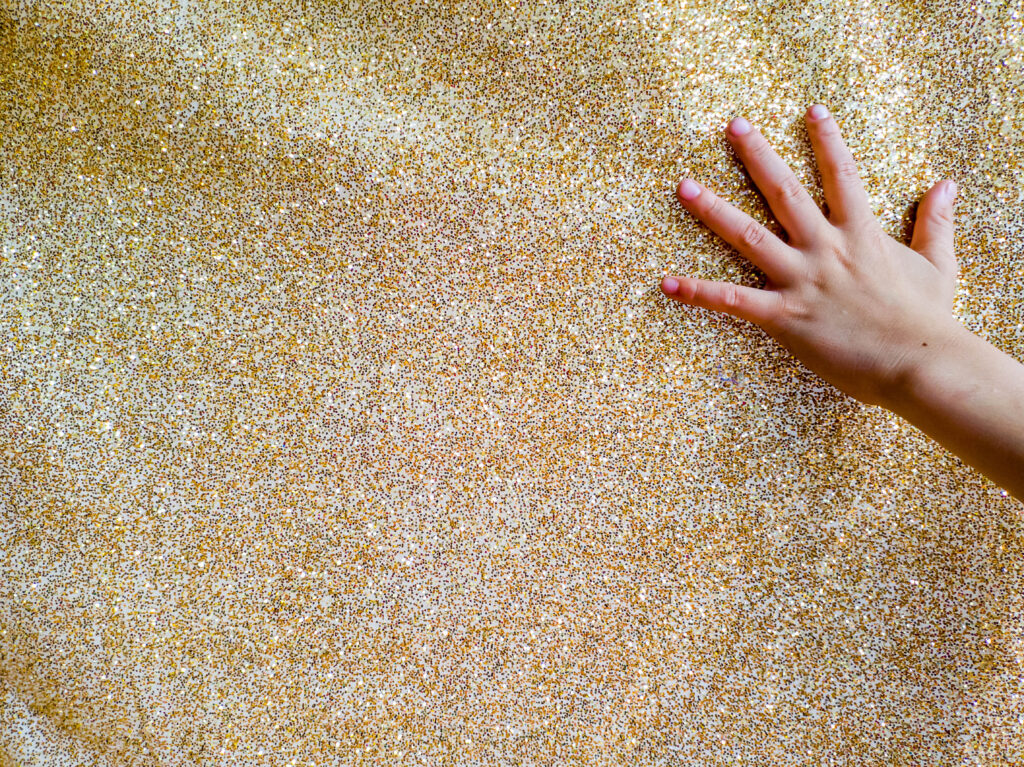Early Montessori activities focus heavily on the refinement of a child's senses – tactile sense being one of them. The Montessori Touch Fabrics is a sensorial material used early in the Montessori primary years to isolate the tactile sense for refinement.
Tactile development is important for so many reasons.
It helps children not only with their ability to discriminate through touch, but with social-emotional development, visual discrimination, and academic progression.
In this article, you will learn about Touch Fabrics and how to introduce this sensorial activity to a child.
You will also get extension activity ideas to help your child make the most out of this material.

(This post contains affiliate links. Purchasing from these links costs you nothing extra, but helps with our website upkeep.)
What are the Montessori Touch Fabrics?
The Montessori Touch Fabrics is a material made up of a wooden box containing 12 squares of fabric – 6 pairs.
The fabric pairs differ in texture from smooth to rough. The purpose of this material is to help refine a child's sense of touch.
Through their work with the Touch Fabrics, children also notice grooves and patterns on the fabric that correspond with its texture.
There is no need to purchase fabrics for this activity if you have some old clothing that is no longer wearable.
Whether you purchase the fabric or use fabric from your home, make sure the squares are all the same size.
The goal is to have the child identify the fabric textures using only their tactile sense.
Here are some fabrics used for this activity:
- The child pairs the fabrics according to the varying textures by…
- wooden box containing 12 matching swatches of a selection of…
- Increase the sense of touch, develop muscle movement (softness,…
When you first introduce this activity to a child, it's best to use similarly colored fabrics.
This is because children should learn to identify the fabrics by feel and not match them by color.
Of course, this is not always possible. Presenting the activity with a blindfold or having the child close their eyes is preferred if matching fabrics are not available.
Along with the introduction of the grading language, coarse, coarser, coarsest, and soft, softer, softest, you can teach the child the names of each different fabric.
For this reason, it's best to avoid synthetic blends with overly complicated names, as this activity is generally introduced very early in the primary years, around the age of 3.
Note: Children can sometimes be hyper or hypo-sensitive to different tactile sensations.
The type of fabric you use should be changed if the child has a negative reaction to it, whether it's a physical reaction or otherwise.
Purpose of the Montessori Touch Fabrics
- development of tactile discrimination of a variety of textures
Indirect aims
- to increase a child's interest in sensorial exploration
- refine a child's control of movement
Control of error
- the appearance of each fabric
- the tactile sensation of each fabric
Point of interest
- the variety of textures
How to present the Montessori Touch Fabrics
Note: Both the adult and child should wash their hands prior to the start of the activity.
As with the Touch Boards and other tactile materials, clean hands help the child accurately discriminate between textures.
- Invite the child to carry the box of Touch Fabrics to the table.
- Take the lid off, put the box on top of the lid, and slide the box to the upper left-hand corner of the workspace.
- Remove the roughest fabric square from the box and set it in front of the child. Tell the child you are going to find the square that matches.
- Run your hand along the fabric square slowly and invite the child to do the same.
- Remove the smoothest fabric square from the box and place it to the right of the roughest square.
- Again, run your hand slowly along the smoothest square and invite the child to do the same.
- Remove the matching smooth square from the box and invite the child to feel it. Then, ask the child if the 2 smooth fabric squares feel the same.
- Repeat the previous step with the roughest fabric square.
- Randomly place the 4 fabric squares (2 roughest and 2 smoothest) around the workspace and ask the child to match them based on their texture.
- If the child is successful and wishes to continue, repeat these steps with the remaining fabric squares, adding them to the activity one by one.
Touch Fabrics extension activities
- Sterognostic activity – Matching the fabrics while wearing a blindfold.
- Grading the fabric squares from roughest to smoothest and smoothest to roughest.
- Finding the patterns on the fabric in a photo or somewhere in the environment.
- Tracing the patterns on the squares.
- Matching different lace patterns while blindfolded.
- Matching different knit or crochet patterns while blindfolded.
- Using the colors from the fabrics for a process art activity.
After working with the Montessori Touch Fabrics, many children will go around touching different items around the classroom or home and describing them.
Children may also begin comparing the textures of different items or even grading them by texture. It's really such a neat thing to witness.
Cheers and don't forget to subscribe!

